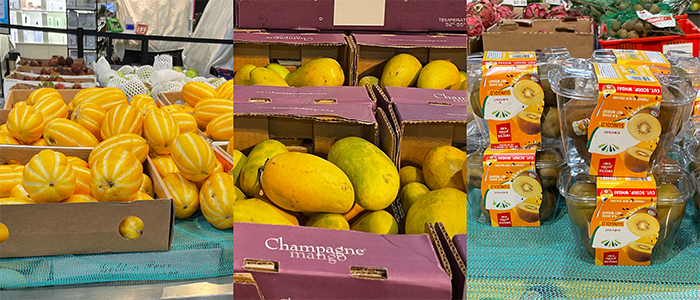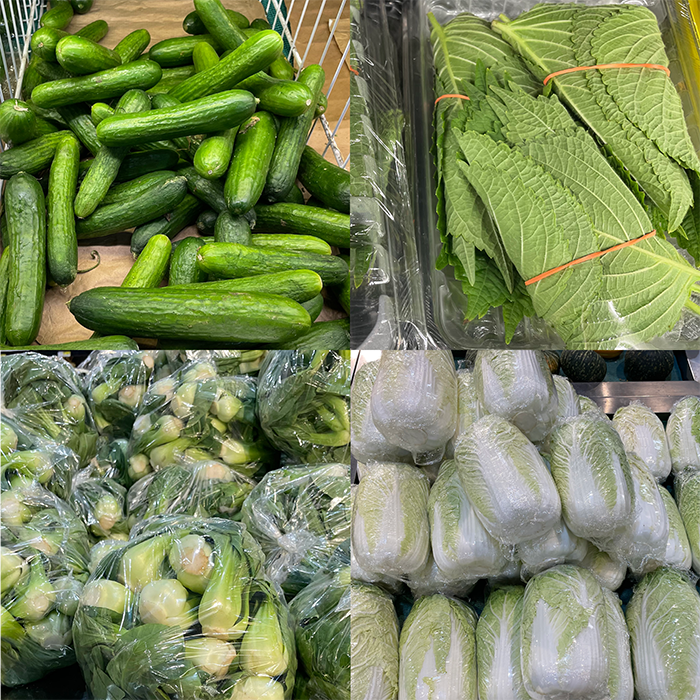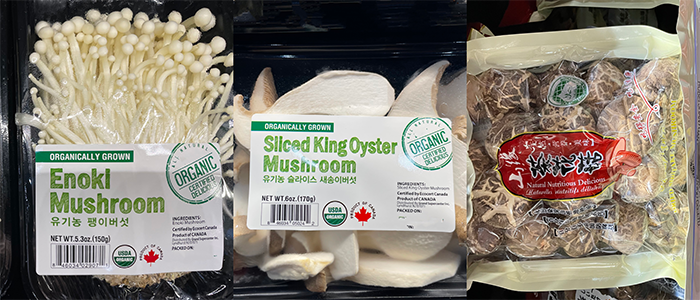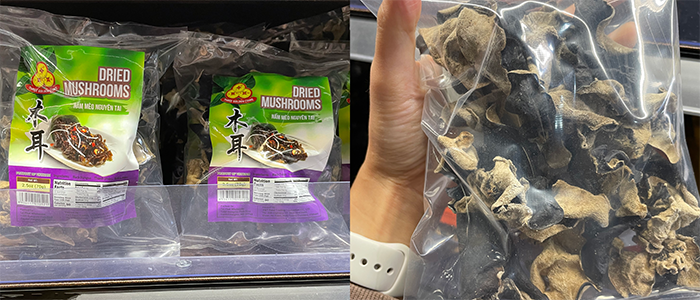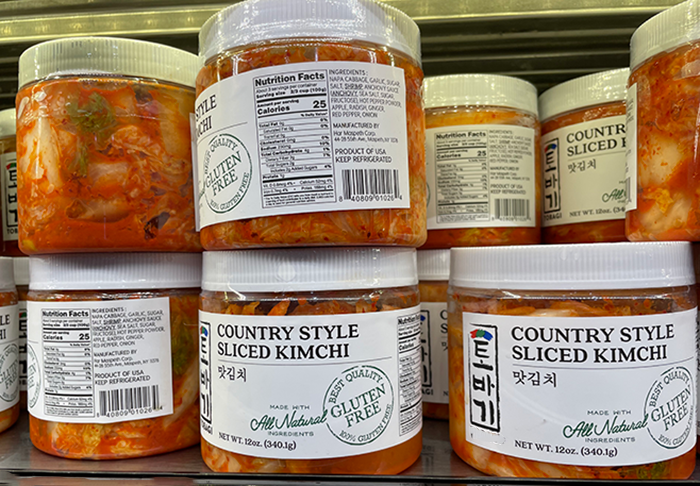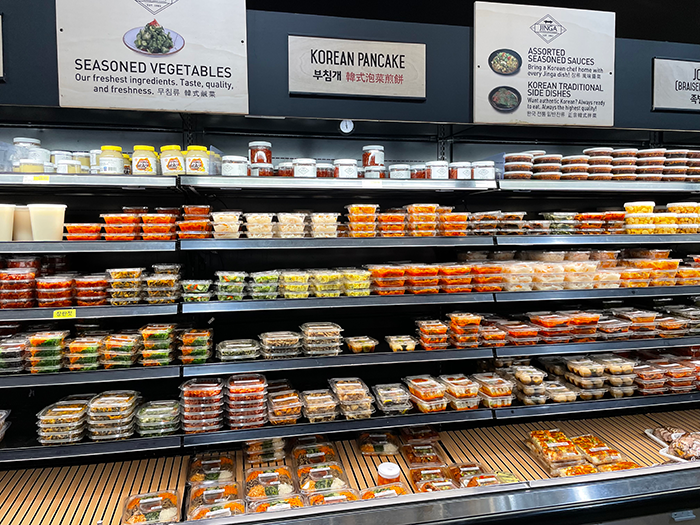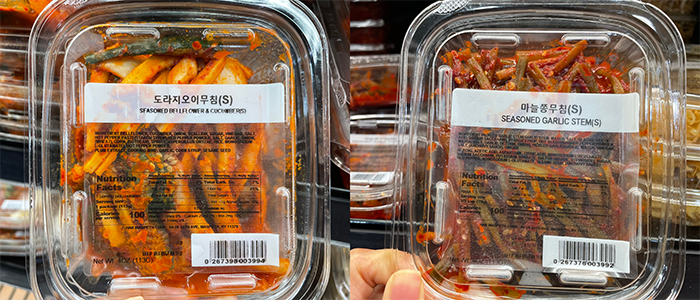Shopping at an Asian grocery store can be intimidating. Even I still get overwhelmed by all the choices. It helps to have a few staples to stick to, which is why I’ve narrowed down the fruit and vegetable essentials – plus a few of my personal favorites.
H Mart places its fruits and vegetables front and center – a dietitian’s dream layout for a grocery store. Immediately as you walk in, you’ll come across colorful in-season fruits. As you look along the sides and towards the back, you’ll find the vegetables.
Step into an Asian grocery store and explore a world of exciting flavors. #saslife #hmart Click To TweetFRUITS
- Korean Melons
The flavor of Korean melons is similar to that of a pear or honeydew melon, but with an extremely crisp and crunchy flesh more akin to a granny smith apple or cucumber. Learn how to tell when the fruit is ripe and see how easy it is to cut and eat the fruit. Both the peel and seeds of the melon are edible, but also easily removed if desired. - Asian Pears
Asian pears are not only a staple fruit of both Korean and Chinese cuisine, but also a key ingredient in many marinades. Check out this Korean BBQ marinade that can be used with beef, chicken or tofu. Asian pears are crunchier than European pears, making them ideal for baking or fruit salads. Try out this pear as is, or experiment with some of these recipes. - Champagne/Ataulfo Mangos
Unlike the red-orange Tommy Atkins mangos more commonly found in the US, champagne mangos are extremely silky, less fibrous and much sweeter. These mangoes are perfect as is, but can also be incorporated into summer desserts such as this coconut mango panna cotta or no sugar added mango sorbet. Make sure to wait until the mango turns a deep yellow and is slightly fragrant for optimal ripeness. - Golden Kiwis
Golden kiwis are not unique to H Mart. However, of the various grocery stores I frequent, H Mart tends to have the cheapest prices. Compared to green kiwis, golden kiwis are more tender, sweeter and easier to prepare. Because the skin separates easily from the flesh, and the center is less fibrous, golden kiwis can be cut in half and eaten with a spoon without being peeled.
VEGETABLES
- Persian Cucumbers
I started buying Persian cucumbers back in college when I was cooking for one and didn’t want to eat cucumbers for 4 meals straight. Persian cucumbers are miniature seedless cucumbers, never more than 5-6 inches long. They have a denser, crunchier texture which I ended up liking more; a win-win! Try this recipe for a spicy or non-spicy version of Korean pickled cucumber, which is commonly eaten at every meal. - Sesame (Perilla) Leaves
Sesame or perilla leaves are commonly used in Korean cuisine in wraps, stews and kimchi. The flavor is similar to a mild basil or mint and pairs perfectly with fattier meats. When buying perilla leaves, choose bright, fresh-looking leaves free of blemishes, browning and wilting. I often make this bulgogi rice wrap and throw a few perilla leaves into each wrap. You can also try these 10 ways to incorporate perilla leaves into your meals. - Green Leafy Vegetables: Shanghai Tips (aka Baby Bok Choy), Chinese Broccoli (Gain Lan), Yu Choy
Many Chinese greens can be cooked the same way. My favorites that are usually in stock at H Mart are baby Bok choy, Chinese broccoli (Gai Lan) or Yu Choy. Asian leafy greens are a blank canvas and soak up any sauce you cook them in. Even though they can be cooked a million different ways, it’s nice to have a foolproof method of stir frying before experimenting with different recipes. After mastering the stir fry and getting used to the flavors and textures of the greens, try out any of these recipes that break down more cooking techniques for Chinese greens. - Napa Cabbage
If you’re a big fan of soups and stews, then Napa cabbage will be your new best friend. Don’t let the size of each cabbage head stop you from trying this versatile vegetable! The cabbage shrinks as it’s cooked. Trust me when I say one head of cabbage only lasts me 2 days. Like other Asian greens, Napa cabbage simply soaks up the soup or sauce it’s in, providing a healthy serving of vegetables with no compromise in taste. I rarely follow recipes and simply throw 5-6 leaves into any stews or soups I’m making such as beef stew, ramen, chicken soup, udon noodle broths, etc. However, if you’d like some recipes to follow, try these 17 recipes varying from Mediterranean to Italian to Mexican inspired dishes.
MUSHROOMS
Mushrooms not only provide the deeper umami flavors found in many Asian recipes but have also been a key component of traditional Chinese medicine. Discover the magic of mushrooms and their immune boosting, inflammation modulating and health promoting qualities.
- Enoki Mushrooms (fresh produce section), King Oyster Mushrooms (fresh produce section), Shiitake Mushrooms (fresh or dried foods aisle – 3-4x cheaper dried)
These three varieties of mushrooms have slightly different tastes and textures from the everyday baby bella or white button mushrooms, and in some ways compliment classic Asian ingredients (i.e., soy sauce, sesame oil, ginger, garlic, chilis) better. Though there are some great recipes that individually feature enoki, king oyster, or shiitake mushrooms separately, my favorite is Korean mushroom rice that combines all three.
- Wood Ear Mushroom (dried foods aisle)
Wood ear mushrooms (sometimes called black fungus or jelly ear mushrooms) are widely eaten in Chinese cuisine and are touted for their health benefits. Wood ear is believed to be one of the more potent mushrooms, improving mild illnesses such as sore throats and fevers, and increasing longevity by decreasing risk of heart disease and neurodegenerative disorders.Unlike the previous 3 mushrooms that have a classic “mushroom umami” flavor, wood ear mushrooms have a lot more texture than taste. They’re usually added into stir fries or soups. Because these mushrooms have a large surface area, the saucier the dish the better. Wood ear mushrooms cannot be eaten raw, so follow these steps to blanch the mushrooms before adding them to any recipe. If you’re not sure where to start, try one of these great recipes.
Working with Dried Mushrooms
Like other preserved or processed foods, most dried mushrooms contain sulfites to maintain shelf-life. However, because sulphur dioxide is water-soluble, immersing the dried foods in warm water can remove most of it. I usually follow these steps while prepping my dried mushrooms.
KIMCHI
Right behind the produce section to your right, you’ll come across what I like to call the “Wall of Kimchi.” Ranging from small jars to gigantic tubs, you may get flustered by all the choices, but don’t be. Like other natural, probiotic fermented foods, kimchi is loaded with gut healing, inflammation reducing, immune balancing bacteria, so they’re definitely worth giving a try.
- Country Style Sliced Kimchi, Cubed Radish Kimchi, Green Onion Kimchi
Tobagi’s Country Style Sliced Kimchi is my personal favorite both in taste and ingredients. Compared to some other brands, it’s lower in added sugar, an ingredient necessary for the fermentation process, but does not compromise in flavor. If you’ve never had kimchi before, I suggest starting with the Sliced Kimchi, which is just Napa cabbage. However, if you’re looking to get more adventurous, a favorite of many is the Country Style Cubed Radish Kimchi and the Green Onion Kimchi. Both have the same sauce, just with a base of radishes or green onions instead of cabbage. Kimchi can be eaten on its own or used as a condiment to add a kick of flavor to grains, eggs, pasta, stews and more.
BANCHAN
Banchan is the collective name for Korean side dishes that are served alongside every meal. H Mart not only has a huge assortment of side dishes, but also provides them in small servings. This really allows you to explore as many new dishes as you want without having to commit to buying a large package. As I’ve gotten more comfortable with Korean cooking, I usually try making my own banchan. However, if you’re still exploring Korean flavors, try one of the following:
- Seasoned Bellflower & Cucumber
- Seasoned Garlic Stems
- Marinated Boiled Eggs
- Pickled Radish and Carrots
Stay tuned for the next blog post where we explore H Mart Pantry Essentials and Snacks.
About the Author
 Tiffany Yeh, Dietetic Intern
Tiffany Yeh, Dietetic Intern
Tiffany received her BS in Nutritional Sciences from Cornell University in 2019. After working in healthcare administration for two years, she decided to pursue a masters at the Gillings School of Public Health at UNC-Chapel Hill. Set to graduate in 2023, Tiffany is looking forward to continuing her career in dietetics in Manhattan. Outside of school and work, she enjoys painting, traveling to see her family in California and Malaysia, and exploring new cities through food.

